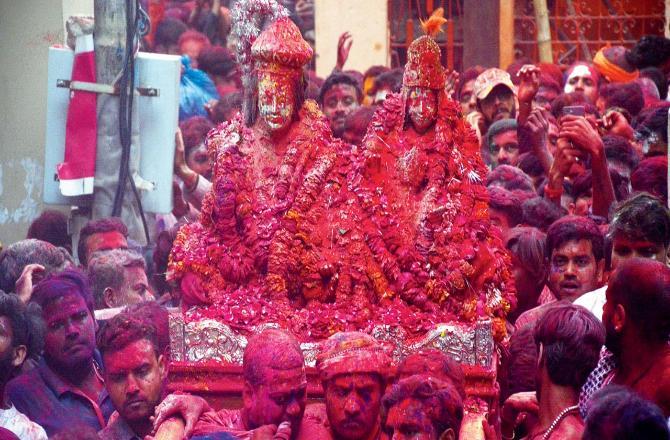In a first for any ancient Indian city, the Banaras Hindu University offers a two-year course to understand the cultural, religious and folklore traditions of Banaras

Hindu devotees, smeared in colour, carry the images of Shiva and Parvati from the Kashi Vishwanath temple during a Holi procession in March 2020. Pic/AFP
On the eve of Dev Deepavali, the Diwali of the Gods, in November, over a million earthen lamps were lit from Ravidas Ghat to Rajghat. Devotees believe that the gods descend to earth to bathe in the Ganges the next day. So the historic city of Kashi, also known as Varanasi or Banaras, is decked up in their honour. "This tradition of lighting the lamps was started in 1985. This time, Prime Minister Narendra Modi graced the occasion. After its subsequent success, it was being discussed that once the COVID-19 pandemic is over, Kashi would become a tourist hub," says Professor Kaushal Kishore Mishra, dean of the social sciences faculty at the Banaras Hindu University (BHU).
ADVERTISEMENT
A few weeks later, the varsity announced the launch of a two-year post-graduate course titled Kashi Study. Mishra believes the course will help students decipher the mystique of the heritage city through academia. A seven-member committee headed by him has worked on the course framework, and it will be presented for approval before the academic council in January. "The admission criteria will be decided once the framework is approved. For now, we have decided to allow foreign students to enroll. The first session under the Faculty of Social Sciences will begin in July 2021. The course will span four semesters with a total of 20 papers. Students, both Indian and international, need to pass all tests in order to get the certificate at the end of the course," he adds.
Professor Kaushal Kishore Mishra
Mishra says that there is a lot of literature available on Kashi, but it's scattered. "In the 1980s, when I was a student, Diana L Eck arrived in Kashi to write her book, Banaras: City of Light. Unfortunately, she had nobody who could introduce her to the true aspects of the city. So, she met with tea stall owners, sadhus at the ghats, pandits in temples and other locals to write this book. Eventually, it became a hit, but it didn't truly represent the rich Banarasi tradition and folklore. We hope the course will."
The students will also get a chance to understand the works of Tulsidas, Kabir, Premchand, Gautam Buddha and Ravidas.
"Kashi ko samajhne ke liye, Kashi ko jeena padta hai. Kashi is an emotion that can be seen and felt only when you have lived it. Currently, the tourist guides too have little or no clue about the real Kashi. Through this course, we are trying to create historians who will put the city on the world's cultural map," he adds.
A major religious hub in India, Kashi is considered the holiest of the seven sacred cities (Sapta Puri) in Hinduism and Jainism, and played an important role in the development of Buddhism and Ravidassia. "The religious culture, musical tradition and sculptural art of Kashi have always mesmerised the world. We already have about 10 applicants for the course from overseas. This was the dream and vision of Pandit Madan Mohan Malaviya, who wanted to take Kashi to the whole world. We are fulfilling his wish," he says of the scholar and educational reformer.
 Subscribe today by clicking the link and stay updated with the latest news!" Click here!
Subscribe today by clicking the link and stay updated with the latest news!" Click here!






